INTRODUCTION
Met is the first-limiting amino acid in corn-soybean based diet of poultry and plays an important role for growth, and egg production, but excess Met supplementation can be toxic for poultry. Besides carcass yield and quality, feather growth is especially important economic trait for meat duck production. Optimum feathering is considered crucial in modern broiler production due to demands for high standards of carcass quality (Lopez-Coello, 2003). Poor feathering increases condemnations and downgrading of birds at slaughtering; it may also decrease the amount of down produced, thus reducing net profit of duck production. Zheng and Zhang (1989) reported that total sulfur amino acid (AA) concentration in contour feathers of duck was 5.1% (DM basis), which was higher than that in chicken (2.9%) or turkey (2.5%). Guo (2011) found the optimal level of Met (0.48%) in 1 to 21 d age Pekin duck’s diet caused a significant increase in feather weight, feather rate, down weight, and down length, but data for ducks be-yond 21 d age are not available.
Feather evaluation has been accomplished, by several subjective methods of detection. Therefore, there is a continual need to develop an objective and convenient way to estimate the feather growth of meat ducks. Cook et al. (2006) reported that the infrared thermography has the potential to be an objective, accurate, and repeatable method of assessing feather cover with obvious advantages over current subjective assessments. Further, they reported mean image temperature provided a real-time assessment of feather cover that was significantly related to a subjective feather scoring in laying hens. In their studies, the thermography measure that most closely approximated feather scoring was determination of feather coverage within specific temperature ranges for a fixed region of the birds’ body. Thus, to authors’ knowledge, this is the first study of applied infrared thermography to evaluate the effect of dietary Met supplementation on feather coverage of meat ducks.
In addition to feather growth and coverage, supplementation of Met to the diet could also improve growth performance and carcass quality of growing broiler chickens (Lemme et al., 2002; Vieira et al., 2004); yet studies on Met effects in meat ducks is relatively small. Xie et al. (2006) reported that the optimal Met requirement for male White Pekin ducks from 21 to 49 d age for maximum weight gain and breast meat yield were 0.377 and 0.379%, respectively. Bons (2000) revealed that concentrations of 0.73 and > 0.84% Met+Cys optimized BW gain and feed-to-gain (F:G) ratio, respectively, in Pekin ducks from 21 to 49 d. Additionally the optimal for breast meat yield was found to be 0.77% Met+Cys. These studies showed that Met requirements of starter (d 1 to 14) or grower (d 14 to 49) Pekin ducks were higher than current NRC (1994) recommendations, which were 0.4 or 0.3%, respectively. Therefore, the objective of this study was to revaluate the responses of Pekin ducks from 15 to 35 d age to dietary Met based on growth performance, carcass characteristics, and feather growth and coverage.
MATERIALS AND METHODS
All animal care and use procedures and protocols were approved by Purdue University Animal Care and Use Committee.
Diet
Five dietary treatments were formulated to contain 0.35, 0.45, 0.55, 0.65, and 0.75% Met of the diets, which contained with 0.07, 0.17, 0.27, 0.37, and 0.48% supple-mental DL-Met, respectively. The other nutrients met or exceeded the requirement of ducks in NRC (1994). Ingredient composition and analyzed nutrients of each diet are presented in Tables 1 and 2. Dietary nitrogen and AA were analyzed using the methods described by Kong and Adeola (2013). The sulfur-containing AA were determined after treatment with formic acid:hydroperchloric acid (9:1) at 0◦C and 24 h before HCl hydrolysis. All diets were fed in pelleted form.
Experiment Design
One-day-old Peking ducklings (n = 2,750) were fed a standard starter diet containing 12.72 MJ ME/kg, 24% CP, 1.33% Lys, 0.7% Met, 0.9% Thr, and 0.5% Trp from 1 to 14 d age. At d 15, the ducks were reallocated to pens so that the mean BW of ducks did not differ across pens. The five treatments were each fed to 10 replicate pens of 55 ducks/pen (0.121 m2/duck). Pens were randomly assigned to all 5 treatments in neighbor-ing pens, but block was not significant in the statistical model and removed from analyses. The floor pens were equipped with feeder, nipple drinker, and raised plastic floors. The environmental temperature and humidity were kept at 29◦C and 60%, respectively, during 1 to 14 d. Afterwards, the temperature was kept at 24◦C. Mortality was recorded daily. On 21, 28, and 35 d age, BW was recorded by pen for determination of ADG, and at d 35 feed consumption was recorded for determination of feed intake and F:G. At d 28 and 35, 4 birds from each pen were randomly selected for evalua-tion of carcass traits according to standard processing procedures. Feed was withdrawn 4 h before processing. Selected birds were weighed, euthanized by exsanguination after stunning, defeathered (including wax bath), and eviscerated. Carcass weight (without neck and feet), breast meat weight, and breast skin and subcutaneous fat weight were obtained after the carcasses were stored on ice overnight. Carcass yield was determined as the carcass weight in relation to live BW and expressed as percentage of BW, whereas breast meat or breast skin and subcutaneous fat yield were expressed as percentage of carcass weight.
Feather Growth
At d 28 and 35, 30 ducks per treatment (3 ducks/pen) were randomly selected for the analysis of feather quality, which included measurements of the length of the left fourth primary wing feather and feather coverage as measured by infrared thermography. The fourth primary feather length was measured using a ruler with a minimum scale of 0.01 mm. Feather coverage was estimated from infrared images taken using a FLIR infrared camera (Model T420, FLIR Systems, Boston, MA), and analyzed using FLIR Reporter Professional software. The dorsal side of each bird was photographed from a fixed distance of 1.0 m while the birds were held upside-down against a white background. The minimum, maximum, range, and mean image temperatures were calculated for a predetermined square area of each image (Figure 1). In this current study, 99.9% of the measured square area of the images fell within a temperature range of 17 to 38◦C. Compared with the regular photo (noninfrared photo), we defined that the temperature between 27 and 35.5◦C was regarded as the proportion of the area of the body not covered by feathers (percentage). At 28 and 35 d age, the size of the measured thermal image was 7.5- and 11.5-cm wide, and 6.1- and 7.0-cm high from the border of axillary cavity to the origin of the tail in the dorsal side, respectively. All birds at the same age were analyzed for the same area with the accordant size. Size of the square image was determined from a randomly selected subset of 10 birds/treatment such that the analyzed image could be consistently analyzed across all ducks. Feather coverage (percentage) = [1−the area of temperature between 27 and 35.5◦C in selected area/the selected total area] × 100% (Figure 1).
Statistical Analysis
The effects of dietary Met concentration on growth performance, carcass characteristics, and feather growth among treatments were analyzed as one-way ANOVA using the GLM procedure in SAS software (SAS Institute Inc., Cary, NC). When dietary treatment was significant (P< 0.05), means were compared using LSD procedure in SAS software. When the diet effect was significant (P< 0.05), polynomial contrasts and the linearity of response to analyzed dietary Met supplement were examined using linear, quadratic, cubic, and quartic regression to determine the model of best fit by the GLM procedure. In addition, the quadratic broken-line regression was computed by the NLIN procedure (Robbins et al., 2006). Finally, Met requirement was estimated using both polynomial (lin-ear or quadratic) and quadratic broken-line regressions when a significant response occurred (P< 0.05). The R2 was provided to compare these regressions (Pesti et al., 2009). The correlation analysis for comparison across feather measures was carried out using the Correl function in Microsoft Excel. Probability values ≤ 0.05 were considered significant.
RESULTS
The analyzed dietary Met concentrations for 0.35, 0.45, 0.55, 0.65, and 0.75% on a formulated basis were determined to be 0.30, 0.39, 0.45, 0.56, and 0.68%, re-spectively (Table 2). All following results and regression data are expressed on an analyzed Met basis.
Growth Performance
The effect of dietary Met on growth performance of Pekin ducks from 15 to 35 d age are presented in Table 3. Ducks fed 0.30% Met had the lowest BW (d 28 and 35), ADG (d 14 to 21 and 28 to 35) and the highest F:G compared to the other dietary treatments (P< 0.05). Increasing dietary Met concentration from 0.30 to 0.68% improved 28-d BW by 3.73%, 35-d BW by 3.59%, ADG of 14 to 35 d age by 4.31%, and decreased F:G by 7.95% (P< 0.05).
Carcass Traits
The effects of dietary Met on carcass traits of Pekin ducks at 28 and 35 d are shown in Table 4 and Table 5, respectively. Increasing dietary Met concentration linearly increased 28-d carcass weight by 6.73% and breast meat weight by 13.4% (P< 0.05). Similarly, the increase in dietary Met from 0.30 to 0.68% improved breast meat by 8.78% (as percent of carcass weight), and reduced breast skin and fat weight by 8.14% (P< 0.05). Feeding 0.30 versus 0.45% Met increased 35-d breast skin and fat by 17 g, while feeding 0.30% versus 0.56% Met reduced 35-d breast meat weight by 41 g (P< 0.05). Dietary Met concentration linearly increased breast meat weight and yield while linearly de-creased breast skin and fat yield (P< 0.05).
Feather Growth
Compared with ducks fed 0.30% Met, the fourth primary wing feather length of 28-day-old ducks fed higher Met diets was significantly longer (Table 6), which increased in a linear or quadratic manner with increasing dietary Met from 0.30 to 0.68% (P< 0.05). Compared to 0.45 and 0.56% Met, 0.30 and 0.39% Met significantly decreased ducks’ feather coverage at 35 d (P< 0.05). However, ducks fed 0.39% Met had the longest average fourth primary wing feather length, which was markedly longer compared to ducks fed 0.30% Met (P< 0.05). At 35 d age, the correlation coefficients were R2 = 0.936 and 0.496 for feather coverage with MT and with fourth primary wing feather length (Table 7).
Optimal Met Requirement of Ducks from Day 15 to 35
According to the polynomial contrast results, significant cubic and quartic responses of carcass characteristics and feather conditions were observed with increasing Met concentration (P< 0.05; Tables 3 to 6). However, it is difficult to reach a plausible biological explanation for the third- and fourth-order responses. Meanwhile, marked linear or quadratic responses of all measures to graded dietary Met were found (P< 0.05; Tables 3 to 6), too. Therefore, in this study, quadratic broken-line regression and quadratic polynomial regression were chose to estimate Met requirement when responses were significant. For ducks to 28 d age, the optimal Met requirement for ducks was estimated to range from 0.404 to 0.51% by quadratic broken-line regression and from 0.559 to 0.606% by quadratic regression (Table 8). The optimal Met requirement to 35 d age was estimated to range from 0.402 to 0.476% by quadratic broken-line regression, and to range from 0.519 to 0.612% by quadratic polynomial regression (Table 8).
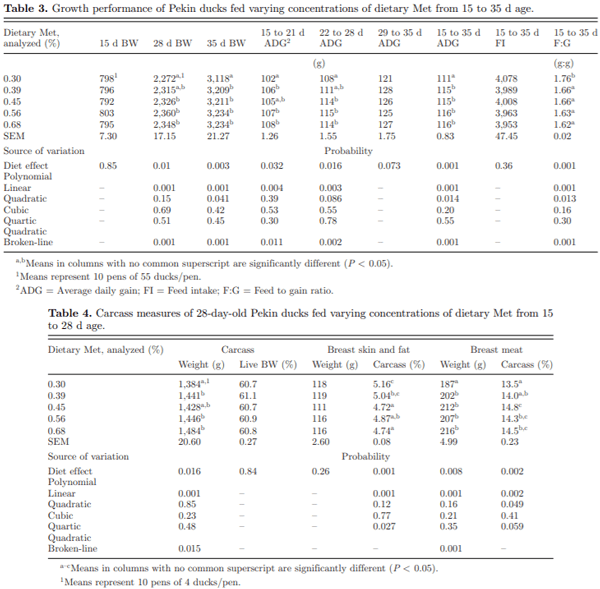
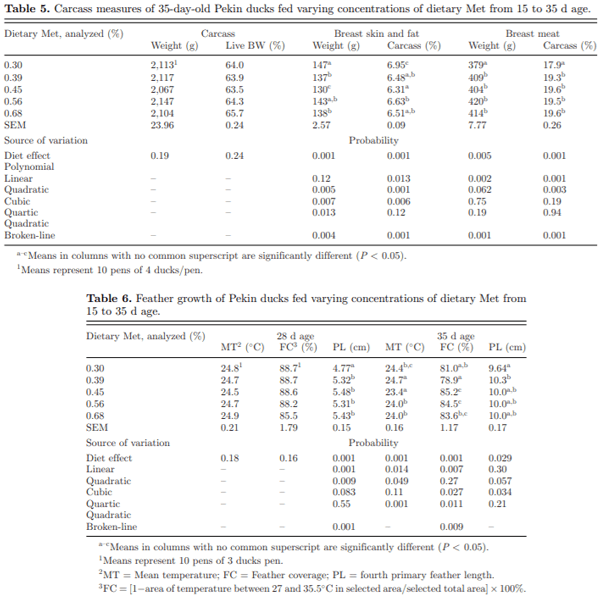
DISCUSSION
The dose-response experimental design is the most frequently used method to assess nutrient requirements of growing animals. When the requirement is expressed as a percentage of feed, the studied nutrient is the first limiting factor and all other nutrients are sufficient. In this study, the analyzed value of protein (> 18%), lysine (> 1.2%), threonine (> 0.7%), tryptophan (> 0.23%), arginine (> 1.1%), cysteine (> 0.25%), and choline (= 1,500 mg/kg) in all dietary treatments exceeded the nutrient requirement of ducks (NRC, 1994). Therefore, the observed responses should only be due to the difference in dietary Met concentration.
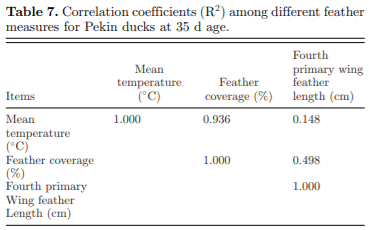
In this current study, as dietary Met concentration increased, the BW, ADG, carcass weight, and breast meat weight or yield increased and then decreased, but F:G and breast skin and fat yield decreased with increasing dietary Met. These results were in agreement with Elkin et al. (1986) and Xie et al. (2004) who observed a similar quadratic response of duck ADG with the increase of dietary Met. Jamroz et al. (2009) found that the supplementation of 0.12% DL-Met to diet containing 0.28% Met (12.55 MJ ME/kg, CP 18.5%) had a positive effect on the productive output of meat ducks from 1 to 42 d age and also improved the apparent ileal digestibility of Cys and Met. Ducks fed 0.47% (1 to 21 d) and 0.42% (22 to 41 d) Met (12.6 MJ ME/kg, CP 19%) had markedly higher BW and breast meat yield at 41 d, but had no significant effect on abdominal fat compared with ducks fed 0.35% Met for 1 to 21 d age and 0.30% Met for 22 to 41 d age (Wang et al., 2004). Luo and Gao (2002) established that the lowest Met requirement of meat ducks from 3 to 5 wk age was 0.35%, 12.55 MJ ME/kg, CP 17.85%). Wu and Yang (2013) recommended that dietary Met requirement for Campbell Sheldrake ducks for 0 to 3, 4 to 6, and 7 to 9 wk age was 0.38 to 0.43% (11.84 MJ ME = 11.84 MJ/kg, CP = 19.57%), 0.40 to 0.45% (ME = 11.67 MJ ME/kg, CP = 17.38%), and 0.35 to 0.40% (ME = 11.72MJ ME/kg, CP = 16.76%), respectively. However, none of the aforementioned studies considered a mathematical model based on analyzed Met concentration basis. In the current study, according to the broken-line regression model, the optimal dietary Met ranged from 0.475 to 0.524, 0.383 to 0.445, and 0.404 to 0.484% based on growth performance, carcass traits, and feather measures, respectively. The maximum responses of dietary Met obtained by quadratic polynomial regression were higher than those obtained by the broken-line regression model. All the Met requirements herein were higher than the recommendations by Xie et al. (2006), who reported that the optimal Met requirement was 0.377 to 0.379% for male White Pekin ducks from 21 to 49 d age based on maximum daily weight gain (69 g/d from 21 to 49 d age) and breast meat yield (10.2% of live weight at 49 d age) based on with quadratic regression. This discrepancy may be due to different dietary ME concentrations or genetic lines of ducks. In the current study, the dietary ME con-tent was 13.37 MJ/kg, which was higher than that in the other studies (Xie et al., 2006; ME = 12.12 MJ/kg). The higher dietary ME concentration often is accompanied with higher dietary nutrient concentrations in the diet, which could influence feed intake. Second, strain differences in meat yield may impact of dietary Met proportional needs for muscle yield. At the same time, we observed that increases in Met improved carcass and breast meat yield, and also led to reduced breast skin and subcutaneous fat in this study.
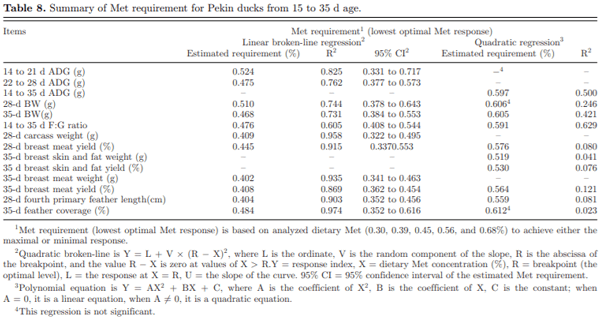
With genetic improvements in growth reducing the time to achieve target BW, there appears to be many problems with feather growth, including poor quality of down, and feather-picking. Feathering may be affected by various factors including nutrition, genetics, environment, and pharmaceuticals (Barbi et al., 2003). Feathers of waterfowl are mainly composed of keratin, which contains 17 AA, with the Met + Cys percentage of all AA being 12% (Harrap and Woods, 1964) and the most important in the synthesis of keratin (Wheeler and Latshaw, 1981). Sulfur AA supplementation into the diet can improve the feather yield and the sulfur content in feather of waterfowl (Wheeler and Latshaw, 1981). In the current study, we observed feather coverage linearly increased, and the fourth primary wing feather length linearly or quadratically increased with increasing dietary Met. At 28 d, ducks fed diets with 0.68% Met had the lowest feather coverage, but at 35 d, ducks fed 0.30 and 0.39% dietary Met had the poorest feather coverage in comparison to those fed the other dietary treatments. According to the broken-line regression, the optimal dietary Met based on the fourth primary wing feather length (d 28) was 0.404% (0.559% by quadratic regression). This requirement increased to 0.484% (0.612% by quadratic regression) by 35 d based on feather coverage. These results were in line with Guo (2011), who reported the optimal Met requirements for maximum feather weight were 0.476%, and for 1,000 down weight and down length were 0.482 and 0.485%, respectively, from 1 to 21 d. Zhang et al. (2014) reported that the fourth primary wing feather was significantly shorter in birds fed 0.57% Thr diet showing that only a severe deficiency of Thr reduced the feather growth of Pekin ducks from 15 to 35 d age. Similarly, the fourth primary feather length was significantly shorter in birds fed 0.30% Met of diet based on the results presented herein, indicating that a deficiency of Met can lead to impaired feather growth of Pekin ducks. Deficiency or imbalance of amino acids may negatively influence feathering in meat ducks. Urdaneta-Rincon and Leeson (2004) found feather weight and feather nitrogen gain of broilers from 1 to 21 d age were more influenced by dietary CP per se (17 vs. 25%) than by levels of lysine (0.86 vs.1.46%). Broilers fed a valine-deficient diet had decreased feather protein (82.7% of wet weight vs. 88% in control birds) and feather Cys (7.04% versus 8.6% of total feather protein; Farran and Thomas, 1992).
Several researchers have utilized subjective feather condition and feather coverage scoring scales. More objective methods of primary feather length and infrared image temperatures were utilized in the current study. Cook et al. (2006) reported a highly significant relationship between mean image temperature and a subjective 4-point feather coverage (feather scoring) on 6 areas (neck, back, wings, tail, dorsal, and ventral) of the body in laying hens. In the current study, both mean temperature and feather coverage (i.e. area within 25 and 37.7◦C) were highly correlated (R 2 = 0.94). However, correlations were much less between these measures and fourth primary wing feather length (R2 = 0.15 and 0.50, respectively). These result showed fourth primary wing feather length and infrared thermography were two objective, complimentary, and convenient ways to estimate the feather characteristics of meat ducks. However, it also emphasizes that primary feather growth may not be directly related to feather coverage. Relatedness to down feather growth and down feather-fill power (an economically desirable trait in ducks) with infrared thermography remains to be determined.
In conclusion, feeding 0.30% Met for ducks from 15 to 35 d age negatively affected performance, meat/carcass yield, and feather growth. To 28 d age, the optimal Met requirement for BW, breast meat yield, and the fourth primary wing feather length were 0.510, 0.445, and 0.404%, respectively, based on quadratic broken-line model; and correspondingly were 0.606, 0.576, and 0.559% based on quadratic regression, respectively. For ducks to 35 d age, the requirement of Met for the BW, breast meat yield, and feather coverage was 0.468, 0.408, and 0.484%, respectively, based on quadratic broken-line model, and correspondingly were 0.605, 0.564, and 0.612%, respectively, based on quadratic regression. The requirement of Met for optimal feather coverage was greater than for BW, F:G, and breast meat yield. The Met requirement for ducks to 28 d age was higher than for ducks to 35 d age based on growth performance and carcass traits. The length of fourth primary wing feather and infrared thermography were two objective and convenient ways to estimate the feather growth of meat ducks.
ACKNOWLEDGMENTS
The authors thank Maple Leaf Farms and Evonik Degussa Corp. for partial funding and research support for this study. The authors also thank Christopher Byrd and Giuseppe Vezzoli for their assistance with thermal imaging.
This article was originally published in 2015 Poultry Science 94:1592–1599. http://dx.doi.org/10.3382/ps/pev117. This is an Open Access article distributed under the terms of the Creative Commons Attribution Non-Commercial License (http://creativecommons.org/licenses/by-nc/4.0/). 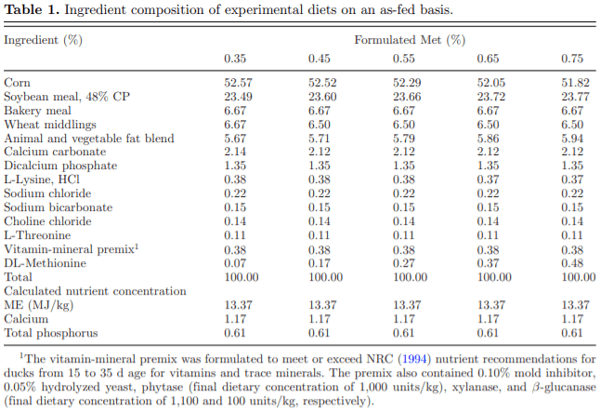
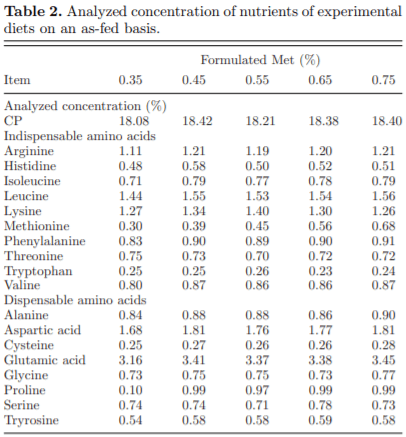














.jpg&w=3840&q=75)